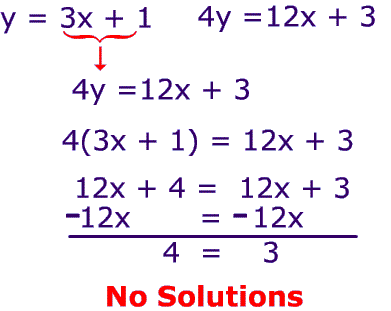

If the compound inequality is 'or', you need to find the union. Then, follow the instructions to make a graph. This is the case that results in No Solution. Solve the following equations to determine if there is one solution, infinitely many solutions, or no solution. When we divide or multiply an inequality by a negative number, the inequality sign reverses. The intersection is: x>5 or in interval notation: (5, infinity) - graph x > -2 and x < -5.

When we divide or multiply an inequality by a positive number, the inequality sign stays the same. Solve the inequality 6u + 8(u 1) > 10u + 32, graph the solution on the number line, and write the solution in interval notation. Graph functions, plot points, visualize algebraic equations, add sliders, animate graphs, and more.
NO SOLUTION GRAPH FREE
The inequality signs reversed their direction. Explore math with our beautiful, free online graphing calculator. In another way, if b 2 < 4ac, the equation will give complex roots with a negative sign within the square root.\]Īre there similar properties for inequalities? What happens to an inequality when we divide or multiply both sides by a constant?ĭoes the inequality stay the same when we divide or multiply by a negative number? 0.5) is a solution We will plot both equations on the graph Since the lines are coincident. The graph of a quadratic with no real solution is a parabola that never touches the x-axis (that is, it is always above or always below the x-axis). Suppose the value of the discriminant is less than 0 (b 2 – 4ac < 0) in the quadratic equation ax2 + bx + c, the equation will have no real solution. Example 5 - Graphically find whether no solution, unique. Let us consider the same quadratic equation x2 4x + 5 0 to conclude. The most widely used method to identify whether a quadratic equation has a solution is by looking at the value of the discriminant. If the graph does not touch the x-axis, it will have no real solution. There are different ways by which we can identify whether a quadratic equation can have a solution or not. The solution to the system is the intersection of the half-planes (or regions) determined by each inequality that is, the solution is the region where all three inequalities are satisfied.
NO SOLUTION GRAPH HOW TO
Discover how to determine whether a system of equations has no solution using graphs, logic, and algebra. A solution for a system of linear Equations can be found by using the. Learn to define a system of equations with no solution. This is called an 'inconsistent' system of equations. Learning Targets Section I represent a linear function as a graph and table 1,2,3. Since parallel lines never cross, then there can be no intersection of these lines that is, for a system of two linear equations that graphs as two parallel lines, there can be no solution.

At times the point of intersection will need to be estimated on the graph. The second graph above, being 'Case 2' in the middle column, shows two distinct lines that are parallel. Some quadratic equations have no real solution. To graph a system of linear inequalities, we graph each inequality on its own coordinate plane. An inconsistent system of equations has no solution.


 0 kommentar(er)
0 kommentar(er)
